Populations of interest
Specific groups within our population can experience significant barriers to accessing oral health care and other forms of disadvantage making them vulnerable to oral disease. Other groups may receive dental services under discrete programs e.g. Veterans. Data pertaining to these specific groups will be presented here as it becomes available.
Veterans
The Department of Veterans’ Affairs (DVA) funds a broad range of dental treatment to clients (eligible veterans and their dependants) through the DVA dental program.
Program eligibility is based on Veteran Card type:
- Gold Card holders are entitled for treatment of all dental conditions where there is a clinical need; and
- White Card holders are only eligible for treatment of their accepted dental condition or the dental consequences of cancer treatment.
A comprehensive suite of dental services is provided under the program, including:
- preventive treatment such as examinations and cleaning
- simple treatment such as fillings and extractions
- complex treatment such as crowns, bridges, implants and dentures
- emergency treatment following unforeseen injuries.
The program operates nationally, and any registered dental practitioner can provide dental services to eligible clients.
The Australian Dental Association (ADA) publishes the Australian Schedule of Dental Services and Glossary (the ADA Schedule) which categorises, lists and defines the range of services that constitute current standard clinical practice. The range of DVA funded dental services conforms to the ADA Schedule. DVA funds a number of ADA dental items across all nine ADA service categories. This covers diagnostic, preventative, periodontics, oral surgery, endodontics, restorative, prosthodontic, orthodontic and miscellaneous services.
DVA dental program utilisation
In each year between 2015–16 and 2021–22, around 6 in 10 eligible male Gold Card holders received dental services.
In each year between 2015–16 and 2021–22, around 4 in 10 eligible female Gold Card holders received dental services.
Between 2015–16 and 2021–22:
- the proportion of eligible male White Card holders receiving dental services varied from 8.5% in 2015–16 to 17% in 2020–21
- the proportion of eligible female White Card holders receiving dental services varied from 9.4% in 2015–16 to 20% in 2020–21.
Explore the data further in Veterans interactive 1.
This figure shows the proportion of eligible Department of Veterans’ Affairs (DVA) clients who received dental services funded by DVA from 2015-–16 to 2021–22. In 2021-22, 60.1% of eligible male Gold card holders received dental services.
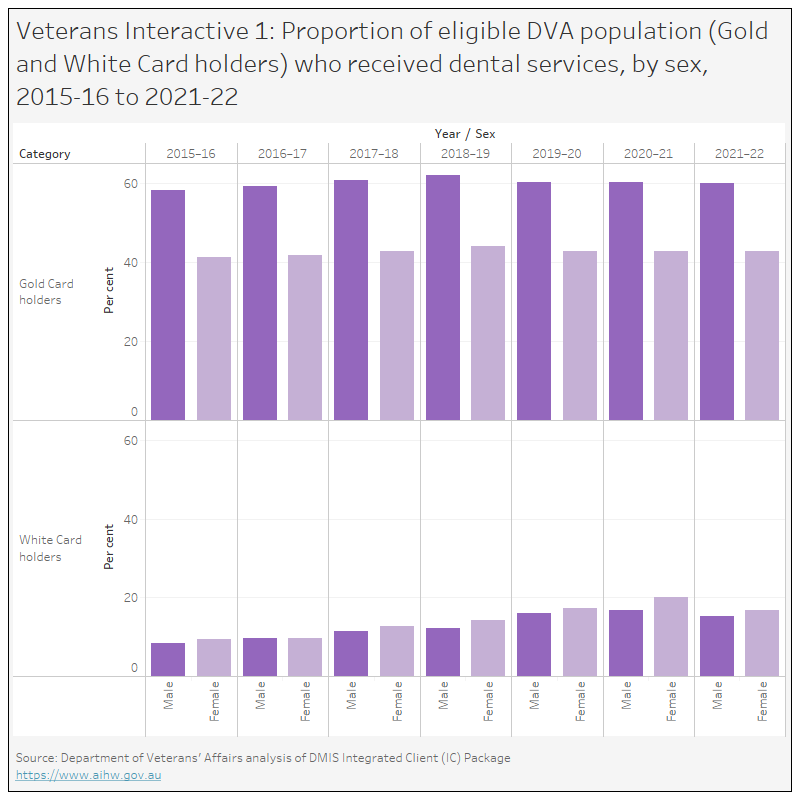
See Data tables: Populations of interest for data tables.
Eligible Gold and White Card holders may receive one or more services (e.g. a diagnostic service and a preventative service) per visit.
In each year between 2015–16 and 2021–22, eligible Gold and White Card holders who received dental services received an average of 10 dental services.
In each year between 2015–16 and 2021–22:
- eligible male Gold and White Card holders that received dental services received an average of 10.6 dental services
- eligible female Gold and White Card holders that received dental services received an average of 8.9 dental services.
Explore the data further in Veterans interactive 2.
This figure shows the average number of Department of Veterans’ Affairs (DVA) funded dental services received annually by eligible DVA clients from 2015–16 to 2021–22. In 2021-22, male DVA clients received an average 10.8 services and female clients received an average 9.2 services.
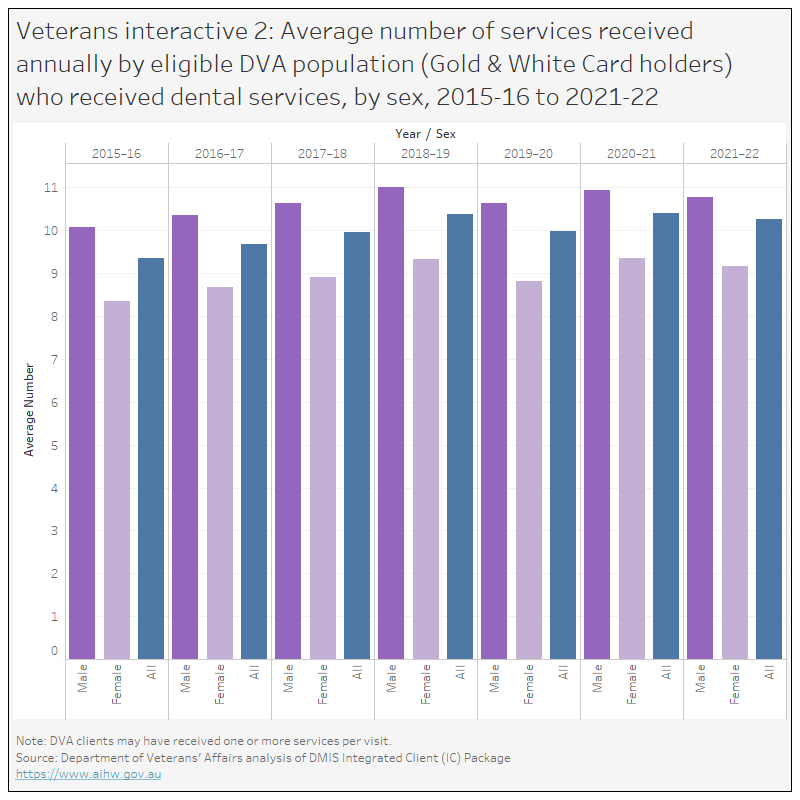
See Data tables: Populations of interest for data tables.
In 2021–22, most Gold and White Card holders who received dental services received a diagnostic service (96%).
In 2021–22, for those Gold and White Card holders who received dental services:
- around 4 in 5 (79%) received a preventative service
- half (50%) received a restorative service
- very few (less than 1%) received an orthodontic service.
This trend was apparent in each year between 2015–16 and 2021–22.
Explore the data further in Veterans interactive 3.
This figure shows the number of eligible Department of Veterans’ Affairs (DVA) clients who received DVA-funded dental services by service category from 2015–16 to 2021–22. In 2021-22, 95.5% received a diagnostic service, 79.3% received a preventative service and 49.6% received a restorative service.
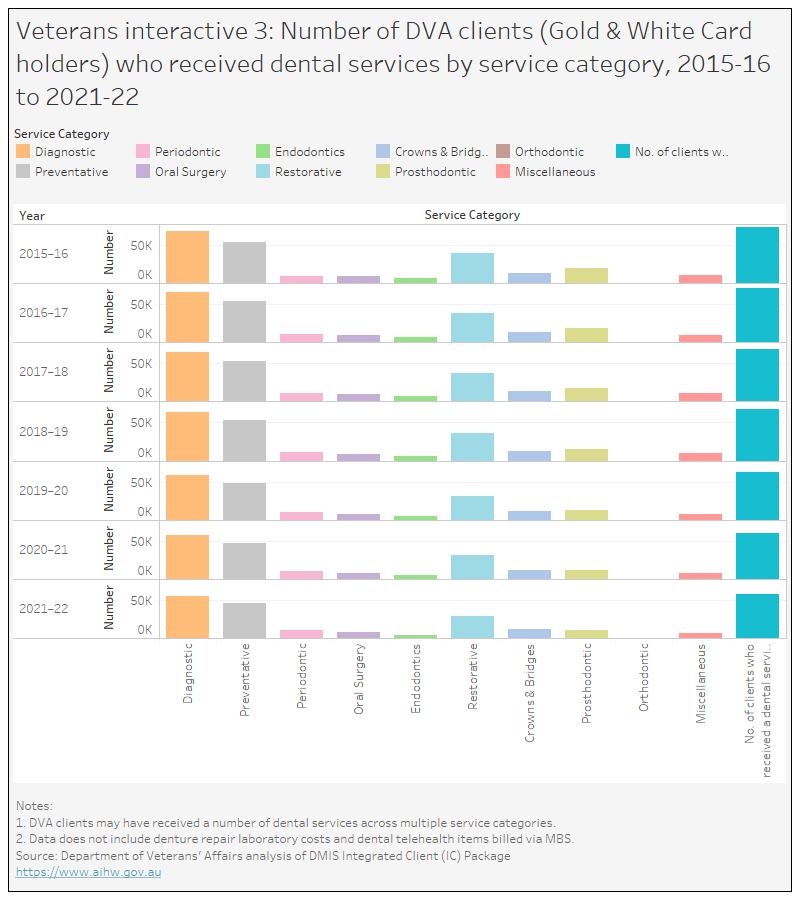
See Data tables: Populations of interest for data tables.
Between 2015–16 and 2021–22, more eligible male Gold Card holders than eligible female Gold Card holders received dental services – around 296,000 services compared to around 180,000 services.
Between 2015–16 and 2021–22:
- more eligible male and female Gold Card holders aged 70–79 years received dental services than any other age group
- fewer male and female eligible Gold Card holders aged 0–19 years received dental services than any other age group
- the number of eligible male Gold Card holders aged 60–69 years who received dental services declined from around 15,200 in 2015–16 to around 5,000 in 2021–22. This decline was also observed for those aged 90+ years, from around 8,500 to 2,200 in 2021–22
- the number of eligible male Gold Card holders aged 70–79 years who received dental services increased from around 12,500 in 2015–16 to around 22,000 in 2021–22
- the number of eligible female Gold Card holders aged 80–89 years who received dental services declined from around 13,900 in 2015–16 to 5,000 in 2021–22
Explore the data further in Veterans interactive 4.
This figure shows the number of eligible Department of Veterans’ Affairs (DVA) clients with gold card entitlements who received a DVA funded dental service by age and sex from 2015–16 to 2021–22. In 2021-22, male DVA clients aged 70 to 79 years received 21,992 dental services dental services funded by DVA.
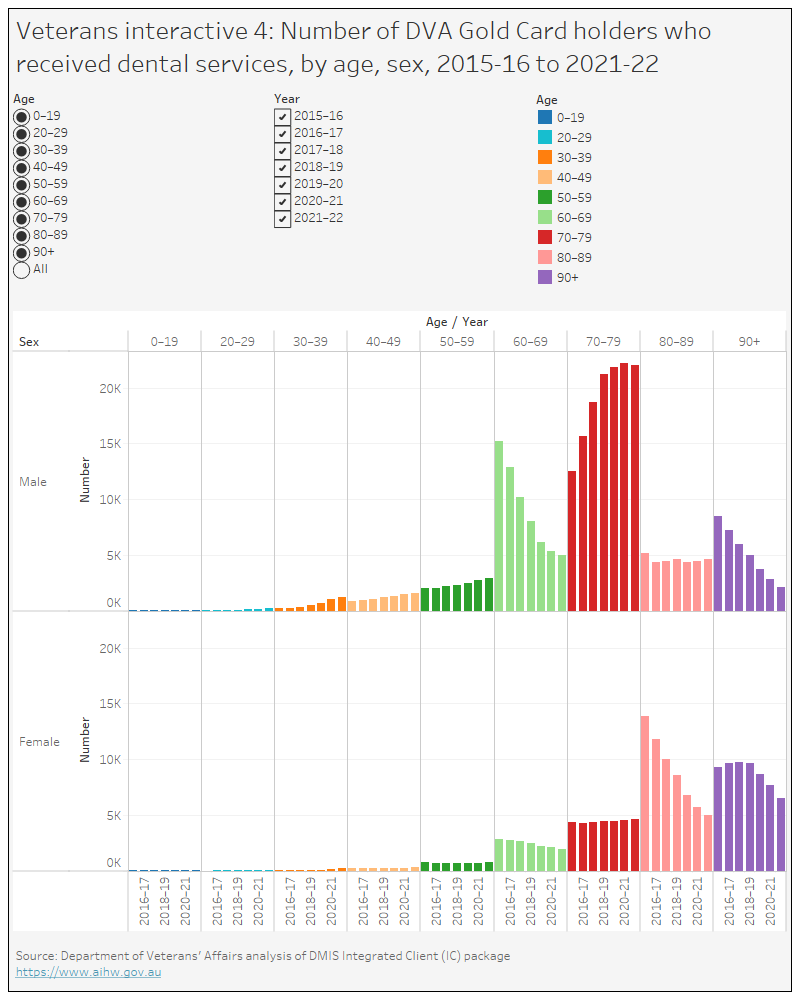
See Data tables: Populations of interest for data tables.
Access to dental practitioners
Under the DVA dental program:
- eligible clients can see the dental practitioner of their choice
- suitably qualified dentists may seek prior approval to deliver treatments in lieu of a dental specialist in rural and remote areas where a dental specialist in not available.
Across Australia, most dental practitioners who provide services to DVA clients are located in Major cities.
Across Australia, between 2015–16 and 2021–22:
- more dentists provided services to DVA clients than either prosthetists or specialists
- the number of dentists in Major cities providing services to DVA clients increased from around 7,900 in 2015–16 to around 9,100 in 2021–22
- the number of prosthetists in Major cities providing services to DVA clients decreased slightly from 660 in 2015–16 to around 510 in 2021–22
- the number of specialists in Major cities providing services to DVA clients increased slightly from around 800 in 2015–16 to around 990 in 2021–22.
Explore the data further in Veterans interactive 5.
This figure shows the number of registered dental practitioners who treated eligible DVA clients by practitioner category, remoteness, state and territory from 2015–16 to 2021–22. In 2021-22, 9,081 dentists in major cities treated DVA clients. Very few dentists, prosthetists and specialists provided services for eligible DVA clients in outer regional, remote or very remote locations.
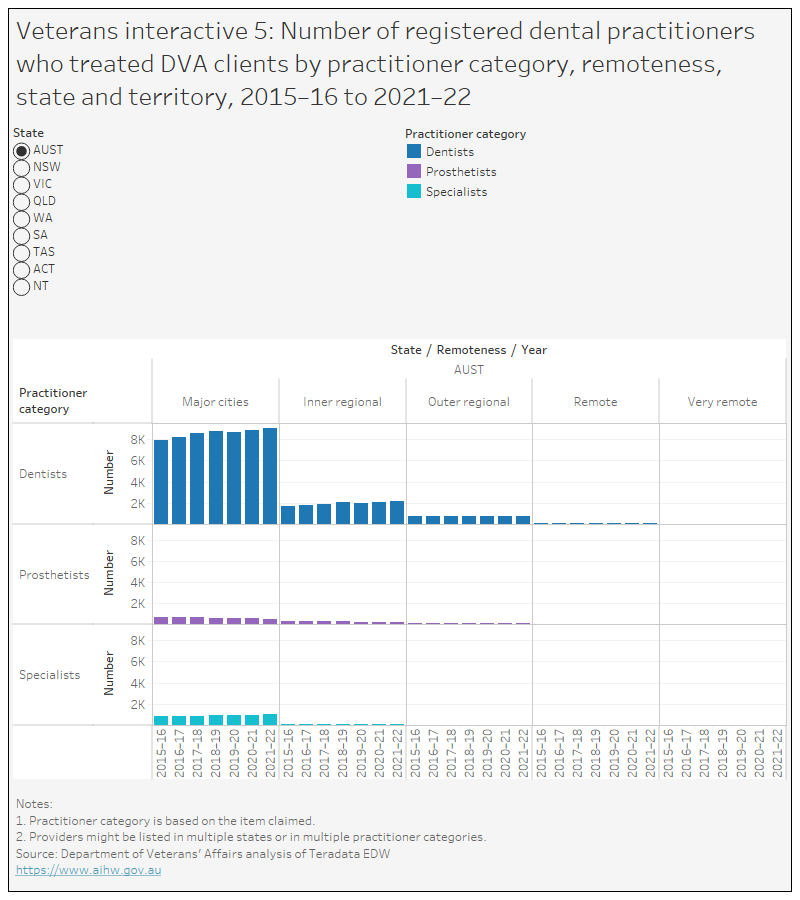
See Data tables: Populations of interest for data tables.


